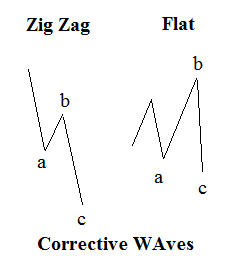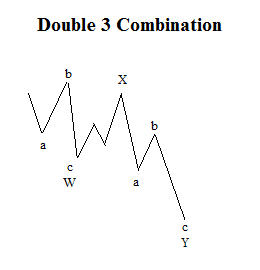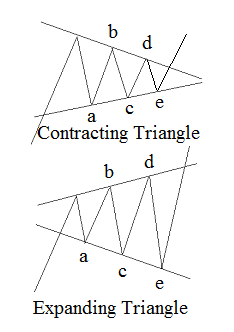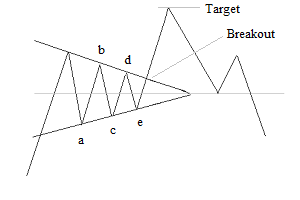Elliott
Wave Theory Basics Explained
Learn Elliott Wave Theory Basics
|
Elliott
Wave Theory Basics Explained - Corrective
Waves
This second part of our Elliott
Wave Theory Basics explained section, looks at
the
analysis of corrective
waves. Corrective waves retrace part of the previous
trend but never move beyond the origin of the previous  impulse
wave.
In
other words wave 2 never
breaks the origin of wave 1 and wave 4 never
breaks the origin of wave 3. impulse
wave.
In
other words wave 2 never
breaks the origin of wave 1 and wave 4 never
breaks the origin of wave 3.
Waves 2 and 4, and A,B,C are corrective waves
The different types of corrective waves are a Zigzag, Flat, Triangle or
a
Combination.
| Wave |
Structure |
Labelling |
| Zigzag |
5-3-5 |
a,b,c |
| Flat |
3-3-5 |
a,b,c |
| Triangle |
3-3-3-3-3 |
a,b,c,d,e |
Elliott
Wave Theory Basics Explained - Combination
Waves
Elliott Wave theory
combination waves
can occur when a corrective wave has not met its price target or needs
to extend in time. Typical combination waves are double
3's or triple
3's where a combination of zigzags or flats is joined together by an
'X' wave. 'X' waves are 3 wave corrective moves.
Double 3's are labelled W,X,Y each of which can be a zigzag or a flat.
W and Y are the Two 3's connected by the X wave.
Triple
3's are labelled W,X,Y,X,Z each of which can be a zigzag or a flat. W,Y
and Z are the Three 3's connected by the Two X waves.
The
final wave in a combination can also be a triangle. Eg: A
very shallow
double 3 (WXY) could consist of a Flat (abc) for W and a Zigzag (abc)
for X, ending in a Triangle (abcde) for Z.
Elliott
Wave Theory Basics Explained - Triangles
As
with all Elliott Wave Theory wave identification, the internal wave
formation is
the most important factor in identifying Triangles in Elliott Wave Theory. Triangles subdivide into
3,3,3,3,3 and are labelled a,b,c,d,e.
It is
important to remember that Elliott Wave
triangles are not determined by shape and contracting
price action in a converging triangular shape does not necessarily mean
that it
is an Elliott Wave Triangle.
A
very common error we have found is that most of the stock
chart
patterns that we
see purported by analysts to be a triangle are not actually valid,
and
is more wishful thinking than through reasoned analysis.
An
Elliott Wave Theory Triangle is a particularly special feature
as they
can only appear at certain points in the cycle, this means that they
can be extremely good guide in confirming to the technical analyst
where we are at that particular point in the cycle.

Elliott Wave Theory
Triangles
Elliott Wave Theory
Basics Explained - Triangle
Positioning
A
genuine Elliott Wave Theory Triangle will only appear in the charts in
certain
positions within the cycle. They always occur in a position prior to
the final wave in a move or as the final wave within a combination as
mentioned earlier.
- Wave
4
- B
wave
- X
wave (final X wave in a Triple 3)
- Final
wave in a Combination
Elliott
Wave Theory Basics Explained - Triangle
Identification
Because
triangles always appear in the position prior to the final move, this
one of the instances where Elliott
Wave theory offers a high value
advantage by identifying some clear and very reliable
trading
opportunities to the trader who has a grasp of the current wave count.
Trading the price ranges as the triangles themselves are
forming tends to be a very high risk trading strategy. As we suggested earlier,
our experience at Traders Day Trading has found that genuine
Elliott wave theory triangles are actually much less common that most
analysts
would have you believe.
We find that too many are over
eager to
identify a range bound market as a triangle simply because the price
range may be converging in that shape. It is likely that the high value
trading opportunity presented by these patterns lead the
analyst to
be open to wrongly identifying it as a triangle.
Price Action Following an Elliott
Wave Triangle
The
price
action following a complete valid Elliott Wave analysis Triangle
count should be fast and furious, producing a spike like
move to a set
target. We can set the
price target by measuring the deepest part
of formation and adding it to the point of the breakout from
the
converging Trend Line drawn through the extremes of waves (b) and
(d). 
Once the price target has been met,
prices will very quickly return to the level of the apex of the
Triangle where it can find some support..
On rare
occasions, the breakout and final move can be long and drawn out as the
final move develops into an Ending Diagonal producing a 'triangle on a
triangle' effect.
Trend reversals from
these points are
extremely sharp and
decisive.
Again, these patterns can occur at any degree of
trend and traders can find them just as useful for day trading as they
do for long term stock analysis.
Triangles
are one of the
most reliable Elliott Wave analysis patterns but traders should take
extra care not to let wishful thinking cloud their judgement
and as
always, should ensure that they identify the point that they know the
pattern has failed and negates its validity.
How
to Trade an Elliott Wave Theory Triangle Successfully
Once
we have identified the possibility that a valid Elliott
Wave Theory
triangle may be forming, our
strategy is to monitor
the development of the pattern until it is
possible to identify a clear and 'complete' wave count.
ie; that the internal
waves all subdivide into the required 3-3-3-3-3 construction.
It
is at this point (e) where we will take our first position based on
this pattern. The initial stop loss level should be placed immediately
below the (c) wave low, and if
this low at (c) is broken the triangle count
immediately becomes null and void.
|
|
|
|